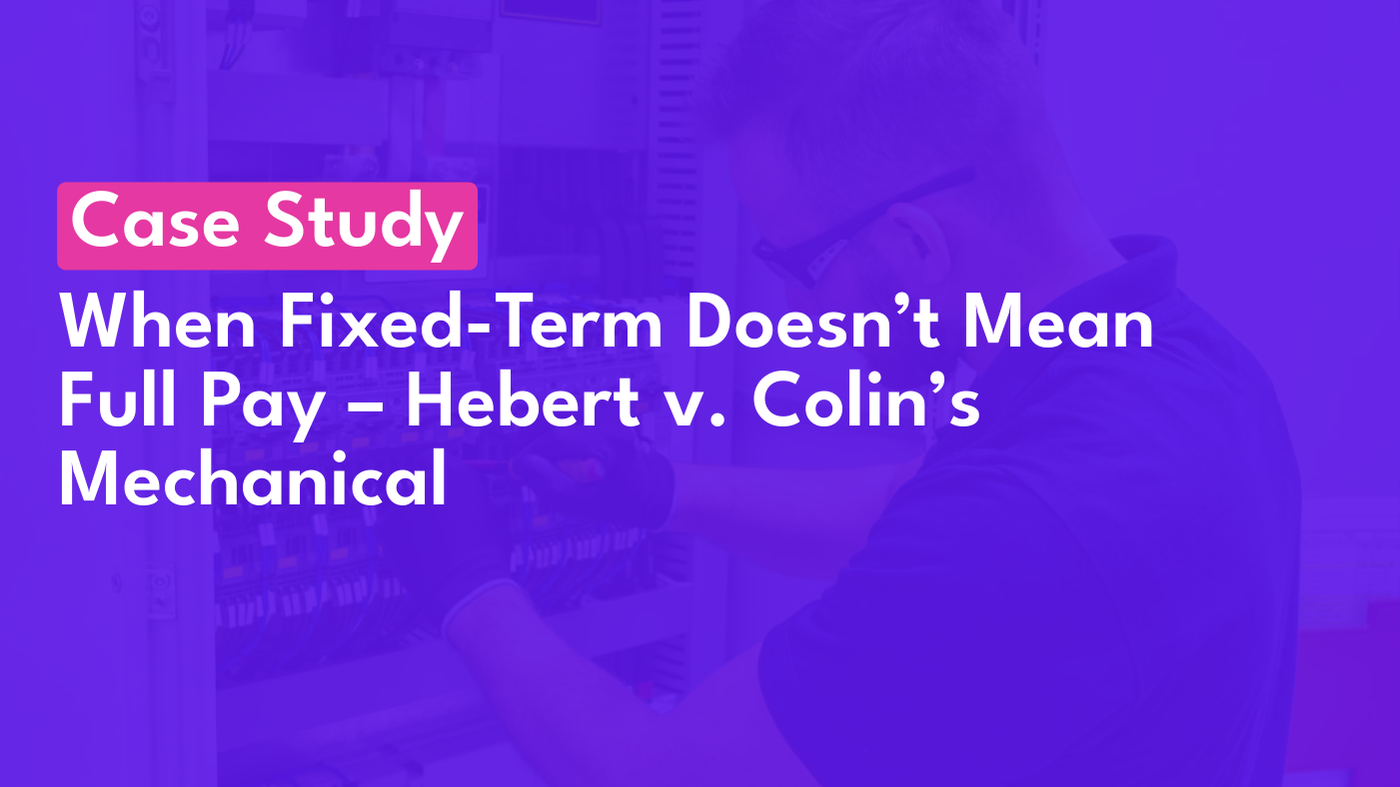Background
Gerald Hebert sold his electrical contracting business, Lineside Electric Ltd., to Colin’s Mechanical Service Ltd. in 2021 for $450,000. As part of the deal, Hebert signed a four-year employment contract with Colin’s Mechanical (August 1, 2021 – July 31, 2025).
- The purchase price included a promissory note of $250,000 payable in annual installments.
- The share purchase agreement required Hebert to enter into the employment contract.
Employment Agreement Highlights
- Fixed-term: Four years.
- Termination without cause: Allows Colin’s Mechanical to terminate Hebert’s employment at any time without cause, subject to notice or pay in lieu under the Employment Standards Code of Manitoba.
- Termination with cause: Defines cause as including theft, fraud, dishonesty, negligence, insubordination, or breaches of contract. Termination for cause allows the employer to terminate without notice or pay in lieu.
- The clause also protected Hebert’s rights under the promissory note, but did not guarantee wages for the remainder of the four-year term.
Termination Clause (Without Cause)
“Colin’s may terminate the Employee’s employment at any time during the Term without cause, subject to notice or payment in lieu of notice or some combination of notice and pay in lieu, in accordance with the Employment Standards Code of Manitoba, but termination by Colin’s without cause shall not prejudice the Employee’s right to the outstanding balance of the Note issued by Colin’s under the Share Purchase Agreement.”
The Dispute
In April 2024, Colin’s Mechanical terminated Hebert’s employment without cause, effective May 1, 2024—15 months before the contract ended.
- Hebert secured alternate employment in August 2024 but at a lower income.
- He sued for the difference between his previous salary and his new earnings for the balance of the contract, arguing:
- The contract guaranteed wages for the full four years.
- The termination clause was ambiguous and should be interpreted in his favour.
- The clause was unenforceable or unreasonable.
- His prior service with Lineside Electric (from 2006) should count for statutory notice under the Employment Standards Code.
Colin’s Mechanical countered that:
- The termination clause clearly limited termination obligations to statutory notice/pay.
- Hebert received four weeks’ notice, exceeding the statutory minimum of two weeks.
Court Analysis
The Court of King’s Bench of Manitoba applied principles from Sattva Capital Corp. v. Creston Moly Corp.:
- Fixed-term contract vs. early termination clause:
- Normally, fixed-term contracts guarantee wages for the full term.
- The termination clause created an early termination right, limiting obligations to statutory notice.
- Clarity of the termination clause:
- The court found it unambiguous and noted that it clearly incorporated the Employment Standards Code.
- Ambiguity and unreasonableness arguments were rejected.
- “Cause” provisions:
- Not invalid; consistent with statutory standards.
- Did not affect the validity of paragraph 5.2.
- Prior employment continuity:
- Hebert argued that service with Lineside should count for notice.
- Share purchase agreement required Lineside to pay any termination entitlements.
- No evidence was provided, so the court did not extend notice.
- Subjective intentions:
- Evidence of Hebert’s expectations or post-contract discussions was inadmissible under the parol evidence rule.
Decision:
- Claim dismissed. Colin’s Mechanical fulfilled statutory notice obligations and owed no additional pay.
Key Lessons for Employers
- Draft termination clauses carefully: Explicitly incorporate statutory notice/pay requirements to limit liability on early termination.
- Define cause clearly: Ensure your cause clause is clear and explains what justifies termination without notice or pay in lieu.
- Align employment and sale agreements: Specify how prior entitlements are handled in business sales to avoid double claims.
- Written contract controls: Courts focus on the written agreement, not subjective expectations or post-contract discussions.
- Statutory compliance matters: Following the Employment Standards Code can shield employers from common law notice claims.
- Plan communication and notice: Provide clear, documented notice and/or pay in lieu to terminated employees.
Bottom Line:
A fixed-term employment contract does not automatically guarantee full wages for the unexpired term if it includes a clear termination clause referencing statutory notice/pay requirements. Employers must draft and follow these clauses carefully to avoid disputes.
Source: https://www.canlii.org/en/mb/mbkb/doc/2025/2025mbkb87/2025mbkb87.html

